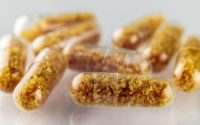Man, 55, has his penis ‘reconstructed’ with Manuka honey
Man, 55, whose penis ‘split’ due to infected tumours has his member ‘reconstructed’ with Manuka honey after a skin graft failed
- Unnamed man went to his GP when his foreskin became too tight to pull back
- Benign tumours were found on ‘all segments of the penis’, causing it to split
- Skin graft failed, medics turned to Manuka dressings, had a ‘satisfying result’
A man whose penis had split due to tumours had his member reconstructed using Manuka honey, doctors have revealed.
The unnamed 55-year-old, from Roskilde in Denmark, went to his GP when his foreskin became too tight to pull back.
Non-cancerous tumours, which were infected, were found on ‘all segments of the penis’. These were causing the skin to split, known as penile denudation.
Medics removed the masses and attempted to reconstruct the penis via a skin graft, which failed.
They then turned to Manuka honey dressings, which had a ‘satisfying result’ and allowed the man to regain ‘full sexual function’.
His penis was ‘completely healed’ 52 days later, the team of medics wrote in the International Journal of Surgery Case Reports.

A man whose penis was split had his genitals reconstructed using Manuka honey (stock)
Many wounds have benefited from Manuka honey, which has anti-bacterial, anti-inflammatory and healing properties, the doctors wrote.
They hope it will soon have a ‘permanent place in the physician’s arsenal of wound-treatment products’.
Mr Tet Yap, consultant urologist at The Princess Grace Hospital, part of HCA UK, told MailOnline: ‘Manuka honey contains a naturally-occurring enzyme that produces hydrogen peroxide.
‘This enzyme is an antiseptic with superior antibacterial and antimicrobial properties, which help to stimulate the skin’s cells.
‘For this reason, medical grade manuka honey has been reportedly used in some hospitals to treat wounds and to help stimulate the immune system, by providing nutrients for cell metabolism, reduced inflammation and rapid tissue repair.’
Penile denudation is a ‘rare and devastating injury’ that can leave men unable to have sex.
Few cases have been reported. Those that have occurred were largely triggered by animal bites, burns, infections, circumcisions and ‘trauma from power-driven tools’.
The man was referred to University Hospital Zealand when he developed a tight foreskin, lower urinary tract infection (UTI) symptoms and a tear in his penis.
Lower UTI symptoms can include straining, dribbling or feeling the bladder is not empty.
He was first thought to have a severe case of balanoposthitis, which occurs when the foreskin and head of the penis become inflamed.
However, an examination revealed the man was circumcised. Tumours were found at the root of his penis, as well as on the shaft and tip.
These were removed, and he was given the antibiotics cefuroxime and metronidazole to prevent infection. Biopsies confirmed the tumours were benign.
The patient was then referred to the hospital’s department of plastic surgery, where he was treated with Manuka honey dressings and antibiotics.
After two weeks, healthy tissue had started to fill the wound. The medics, led by Dr Amalie Sylvester-Hvid, then took a split-thickness skin graft (STSG) from the man’s thigh.
WHAT IS PENILE DENUDATION?
Penile denudation occurs when the skin of the genitals has eroded.
This can take place when the surface layers of the skin are ‘torn away’, or if the tissue dies due to disease, injury or a lack of blood supply.
Urinary extravasation can also be to blame.
This occurs when the urethra is blocked, causing urine to accumulate in the penis.
Penile denudation is often a complication of circumcision. It is unclear how many men are affected.
The skin usually has to be replaced via a split-thickness skin graft.
This involves taking skin from one area of the body and transplanting it to another.
Unlike a full-thickness graft, only part of the dermis is taken.
STSG is the go-to treatment for penile deduction. It involves taking skin from one area of the body and transplanting it to another. Unlike a full-thickness graft, only part of the dermis is taken.
This was unsuccessful, prompting the medics to remove the graft a week later.
They then went back to using Manuka honey dressings due to them being ‘uncomplicated so far’.
The man removed the dressings every other day without complications, recurrent infections or pain.
‘The patient regained full sexual function and was satisfied with both the functional as well as the aesthetic result,’ the medics wrote.
Medical grade Manuka honey has been effective in the treatment of everything from gangrene to diabetic leg ulcers and burns.
It has a pH of between 3.2 and 4.5, which ‘promotes healing by increasing the release of oxygen from haemoglobin (Hb)’, the doctors wrote. Hb is the protein in red blood cells that carries oxygen around the body.
The medics claim Manuka honey’s ‘simplicity, low cost and effectiveness’ make it a ‘good alternative’ to reconstructive surgery for the ‘genital region’.
They also believe it could be used as an alternative to antibiotics amid the resistance crisis.
‘The growing challenge of bacterial resistance to antibiotics has led to the development of several options of conservative wound treatment,’ the team wrote.
‘None of them have shown the combined wound healing attributes found in medical-grade honey.
‘Studies have shown a range of species of bacteria, including MRSA and vancomycin resistant enterococci, are susceptible to the antibacterial activity of honey without developing resistance.
‘Considering the adverse effects of conventional antibiotics and the increasing resistance to antibiotics, we hope that Manuka honey soon finds a more permanent place in the physician’s arsenal of wound treatment products.’
Source: Read Full Article


